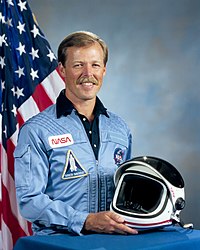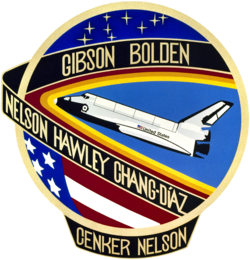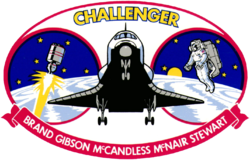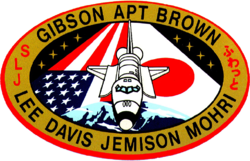Robert L. Gibson
| Den här artikeln omfattas av Wikipedias policy om biografier. Den saknar källhänvisningar och kan inte verifieras. (2024-05) Åtgärda genom att lägga till pålitliga källor (gärna som fotnoter). Uppgifter utan källhänvisning kan ifrågasättas och tas bort utan att det behöver diskuteras på diskussionssidan. |
| Robert L. Gibson | |
 | |
| NASA-astronaut | |
|---|---|
| Tillstånd | Ej aktiv |
| Född | 30 oktober 1946 |
| Tid i rymden | 36 dagar, 4 timmar, 15 minuter |
| Urvalsgrupp | Astronautgrupp 8 den 16 januari 1978 |
| Uppdrag | STS-41-B, STS-61-C, STS-27, STS-47, STS-71 |
| Uppdragsemblem | |
Robert Lee "Hoot" Gibson, född 30 oktober 1946 i Cooperstown, New York, är en amerikansk astronaut uttagen i astronautgrupp 8 den 16 januari 1978.
Han är gift med astronauten Margaret Rhea Seddon.
Rymdfärder
Källor
”Biographical Data” (på engelska) (PDF). NASA. september 1997. https://www.nasa.gov/wp-content/uploads/2016/01/gibson_robert.pdf. Läst 7 maj 2024.
Media som används på denna webbplats
Författare/Upphovsman: Tkgd2007, Licens: CC BY-SA 3.0
A new incarnation of Image:Question_book-3.svg, which was uploaded by user AzaToth. This file is available on the English version of Wikipedia under the filename en:Image:Question book-new.svg
STS-27 Mission Insignia
S84-42271 (24 Sept. 1984) --- Astronaut Robert L. Gibson.
STS-61-c mission patch
- Columbia, which opened the era of the Space Transportation System with four orbital flight tests, is featured in re-entry in the emblem designed by the STS-61C crew representing the seven team members who manned the vehicle for its seventh STS mission. Gold lettering against black background honors the astronaut crewmembers on the delta pattern surrounding colorful re-entry shock waves, and the payload specialists are honored similarly below the sphere.
STS-71 Mission Insignia
The STS-71 crew patch design depicts the orbiter Atlantis in the process of the first international docking mission of the Space Shuttle Atlantis with the Russian Space Station Mir. The names of the 10 astronauts and cosmonauts who flew aboard the orbiter are shown along the outer border of the patch. The rising sun symbolizes the dawn of a new era of cooperation between the two countries. The vehicles Atlantis and Mir are shown in separate circles converging at the center of the emblem symbolizing the merger of the space programs of the two space faring nations. The flags of the United States and Russia emphasize the equal partnership of the mission. The joint program symbol at the lower center of the patch acknowledges the extensive contributions made by the Mission Control Centers (MCC) of both countries. The crew insignia was designed by aviation and space artist, Bob McCall, who also designed the crew patch for the Apollo Soyuz Test Project (ASTP) in 1975, the first international space docking mission.
The mission emblem of STS-47 depicts the Space Shuttle Orbiter with the Spacelab module in the cargo bay against a backdrop of the flags of the United States and Japan, symbolizing the side-by-side cooperation of the two nations in this mission. The land masses of Japan and Alaska are represented on the emblem emphasizing the multi-national aspect of the flight as well as the high inclination orbit of 57 degrees. The initials `SLJ' on the left border of the emblem stand for Spacelab Japan, but the name generally used for the mission is `Spacelab-J.' The Japanese characters on the right border form the word `Fuwatto' which is the Japanese word for weightlessness.






